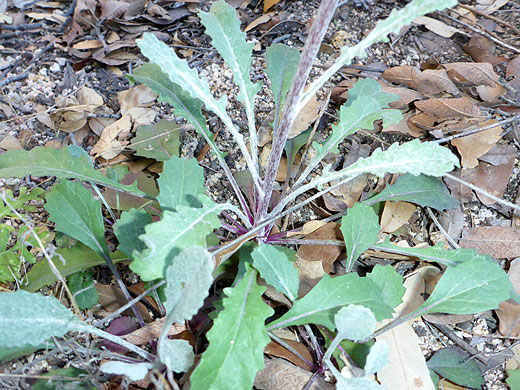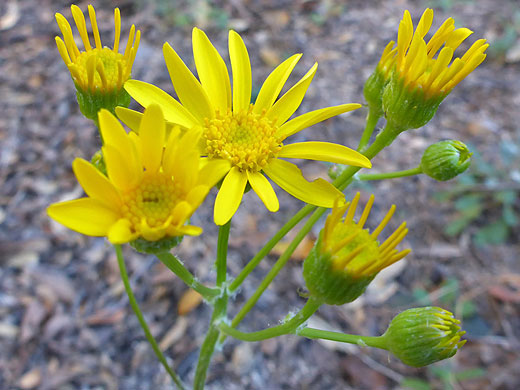Common name:
New mexico groundsel
Family:
Scientific name:
Packera neomexicana
Main flower color:
Range:
Arizona, New Mexico and west Texas
Height:
Between 8 and 20 inches
Habitat:
Chaparral, meadows, oak and conifer woodland; up to 10,000 feet
Leaves:
Basal leaves are lanceolate to ovate, up to 2.5 inches long, on stalks, with toothed edges and a covering of cobwebby hairs
Season:
April to July
Packera neomexicana is a relatively low-growing species, less than 2 feet tall, producing between one and five stems, closely spaced, which have leaves mostly around the base. Stems are often purplish near the ground, green higher up, and they have a thin covering of tomentose hairs. Basal leaves grow on stalks (petioles) which may also be purplish, and hairy. The base of the leaf blades taper gradually to the stalk. Leaf margins may be almost entire, but more usually have teeth, coarse or fine. Stem leaves are much smaller, alternately arranged, and few in number. The uppermost leaves are sessile, and have entire edges.
The inflorescence is a cluster of between 3 and 20 flowerheads, which have 5 to 14 yellow ray florets (usually at least 8), 40 to more than 60 yellow disc florets, and a cup-shaped involucre lined by 13 or 21 green phyllaries. These are of equal length, and may be hairless, or lightly tomentose hairy.
There are three varieties: var mutabilis is mostly or completely hairless and has narrow basal leaves, while the other two are hairy and have wider basal leaves - they are var neomexicana, which has regular stem leaves, and the uncommon var toumeyi, which has small, bract-like stem leaves.
The inflorescence is a cluster of between 3 and 20 flowerheads, which have 5 to 14 yellow ray florets (usually at least 8), 40 to more than 60 yellow disc florets, and a cup-shaped involucre lined by 13 or 21 green phyllaries. These are of equal length, and may be hairless, or lightly tomentose hairy.
There are three varieties: var mutabilis is mostly or completely hairless and has narrow basal leaves, while the other two are hairy and have wider basal leaves - they are var neomexicana, which has regular stem leaves, and the uncommon var toumeyi, which has small, bract-like stem leaves.
All Contents © Copyright The American Southwest | Comments and Questions | Contribute | Site Map











